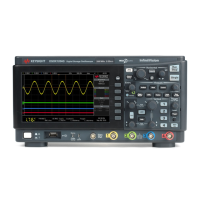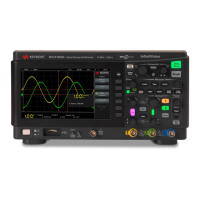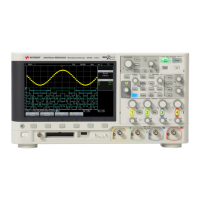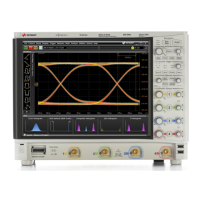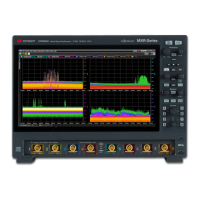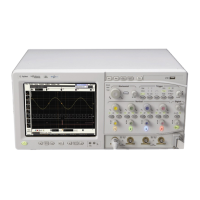154 Keysight InfiniiVision HD3-Series Oscilloscopes User's Guide
11 Trigger Mode and Conditioning
Noisy Signals If the signal you are probing is noisy, you can set up the oscilloscope to reduce the
noise in the trigger path and on the displayed waveform. First, stabilize the
displayed waveform by removing the noise from the trigger path. Second, reduce
the noise on the displayed waveform.
1 Connect a signal to the oscilloscope and obtain a stable display.
2 Remove the noise from the trigger path by turning on high-frequency rejection
(
"To enable or disable trigger HF Reject" on page 157), low-frequency
rejection ("To select the trigger coupling" on page 155), or "To enable or
disable trigger noise rejection"
on page 157.
3 Use "Averaging Acquisition Mode" on page 169 to reduce noise on the
displayed waveform.
To select the Auto or Trig'd trigger mode
When the oscilloscope is running, the trigger mode tells the oscilloscope what to
do when triggers are not occurring.
In the Auto trigger mode (the default setting), if the specified trigger conditions are
not found, triggers are forced and acquisitions are made so that signal activity is
displayed on the oscilloscope.
In the Trig'd trigger mode, triggers and acquisitions only occur when the specified
trigger conditions are found.
To select the trigger mode:
1 Open the Trigger dialog box (by selecting the trigger badge or by choosing
Trigger > Setup... from the main menu).
2 Select the Mode drop-down list; then, select either Auto or Trig'd.
See the following
"When to Use Auto Trigger Mode" on page 155 and "When
to Use Trig'd Trigger Mode"
on page 155 descriptions.
You can also configure the Setup > (Quick Action) menu item to toggle between the
Auto and Trig'd trigger modes. See
"Configuring the (Quick Action) Menu Item" on
page 291.
Triggering and the
Pre- and
Post-Trigger
Buffers
After the oscilloscope starts running (after pressing [Run] or [Single] or changing
the trigger condition), the oscilloscope first fills the pre-trigger buffer. Then, after
the pre-trigger buffer is filled, the oscilloscope starts searching for a trigger, and
sampled data continues to flow data through the pre-trigger buffer in a first-in
first-out (FIFO) manner.
When a trigger is found, the pre-trigger buffer contains the events that occurred
just before the trigger. Then, the oscilloscope fills the post-trigger buffer and
displays the acquisition memory. If the acquisition was initiated by [Run/Stop], the
process repeats. If the acquisition was initiated by pressing [Single], the acquisition
stops (and you can Pan and Zoom the waveform).
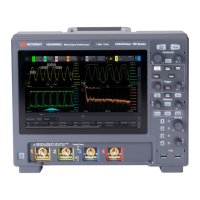
